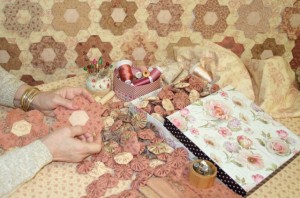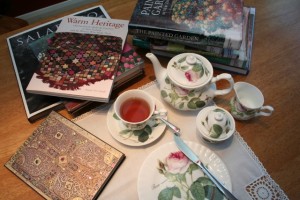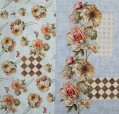Our quilts are a record of the decisions we make, which will be decoded by our ancestors in years to come. I think of this so often when I study the old New Zealand quilts and coverlets in Warm Heritage.
Every time I look through the book I wonder if Maria Hackworth, Jane Philips Tryon, Linda Monro, or the McClure family, ever thought that their quilts would someday be the subject of a book or the source of inspiration for a new generation of quilters.
Nostalgia is often described as the past hindering the present, but the old patchwork quilts and coverlets have deepened my respect for traditional quilts and the craft of quilt making.
As I explore some of the techniques used by the pioneers, I realise that they too faced the same decision-making moments – with much less resources. In addition to big decisions, they too must have struggled with the mundane of changing thread yet again, or unpicking for a third time.
Since my last progress report, I have had to make many creative, technical, and practical quilt decisions – some easy, some not so easy, some reversible, and some not.
Every decision has implications and I have to remind myself that there will be mistakes and that it is often in the mistakes where the value, truth, and honesty of a quilt lies.
Often when I am waiting for a big quilt to happen, I make small thinking cloths to explore a decision, concept, or technique, and I have made quite a few thinking cloths in the past two months.
I usually hang on to these cloths, as they are special to me. They reflect my thinking process when I work towards a show. However, when I show my work, I usually let some of them go as wrapping cloths or I give them away.
Life has taken on a pleasant routine; rising before dawn, reading, quilt until lunchtime, work at the library till six, dinner at seven, and then more quilting – until midnight. Most days.
Of course the long hours are partly due to the looming deadline, but it is also by choice because I am so inspired, excited, and motivated. Even when I am not at the quilt table I am dreaming, planning, and making decisions.
I usually start my day with quiet reading time at the breakfast table. I have been doing this for years and the first decision I took – early in the project – was to limit my morning reading to books that relate to my exhibition theme, so that I do not lose focus of my original vision.
This was a good and rewarding decision because the walled garden in literature is a rich area to explore. It features in, among others, The Song of Solomon, Le Roman de la Rose, Rappaccini’s Daughter, The Cottage Hospital, The Merchant’s Tale, The Secret Garden by Frances Hodgson Burnett, Paradise Lost, Pamela, The Magician’s Nephew, and The Selfish Giant.
I love the way Ian McEwan places his main character in Sweet Tooth with the sentence: ‘We grew up inside a walled garden, with all the pleasures and limitations that implies.’
In art, the garden wall often separates the everyday from paradise and during my morning reading, artists allow me to peer over the wall into the wonderful walled gardens of the Virgin in the Rose Bower, Emilia in Her Garden, Ladies in a Garden Embroidering, Two Women in a Bower, Convent Thoughts, Broken Vows, Pilgrim at the Gate of Idleness, Christ as a Gardener, The Garden of Love, Offering of the Heart, The Swing, Annunciation, Madonna of the Rose Bower, Garden of Paradise, and many more.
I carry these images in my head but at the quilt table I have come to accept that a quilt can never be a painting. And I don’t even want to go there. Instead, I try to distil the essence and evoke a feeling with colour and floral fabrics. In addition, I am often inspired by the words authors use to describe the abundance, decadence, pleasure, or solitude of the walled garden.
Some of my technical decisions are based on these gardens in art and literature. I am working on a Suffolk Puff trellis, a lawn strewn with paper pieced flowers, a walled garden medallion quilt, a Broderie Perse rose bower, a chequered floor and – time permits – a hexagon fountain and a Shapiro fan.
Although the basic principles of traditional quilting are still the same, technology provides many timesaving tools and materials. As such, I am using fusible web for appliqué, pre-cut paper shapes for piecing, and a wonderful plastic tool to make Suffolk Puffs.
But one of the most important decisions that I have made was to seek the help of a long-arm quilter and I asked Linda Young to help me quilt some of the big quilts.
I have always admired the integrity of Linda’s work and I am deeply grateful that she has agreed to help me. I feel completely safe in her hands because she has a wonderful way of making me feel at ease when I do not even know what questions to ask.
As I have a small domestic sewing machine, I am aware of my own sewing limitations and I strongly believe that long-arm quilting will give my quilts a better finish and a longer life. Linda’s advice and suggestions have been invaluable and with her help I may just make it to opening night.
I hope to report on the completed quilts in my next scholarship update – in two months – just before the opening of the exhibition on the 23rd of August.



